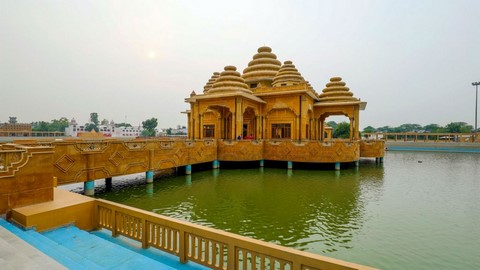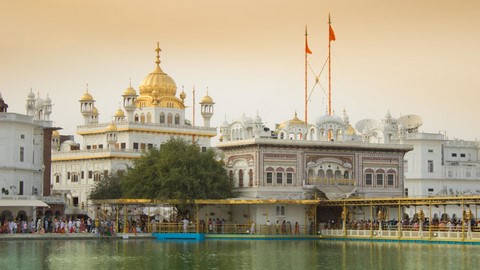The Bada Hanuman Mandir, also known as the Langoorwala Hanuman Mandir, is a prominent Hindu temple situated in Amritsar, Punjab. Located at the northwestern corner of the Durgiana Temple complex, this temple is dedicated to Lord Hanuman and holds significant religious importance for devotees.
 Historical Significance:
Historical Significance:
According to local legends and Hindu scriptures, this site is closely associated with events from the Ramayana. It is believed that Lord Rama performed the Ashwamedha Yagna (a horse sacrifice ritual) here. During this event, the ceremonial horse was captured by Luv and Kush, the twin sons of Lord Rama and Sita, who were residing in the area at the time. When Lord Hanuman attempted to retrieve the horse, Luv and Kush engaged in a battle with him and eventually tied him to a tree. The temple is said to be constructed on the very site where these events unfolded, enhancing its spiritual significance.
Architectural Features:
The temple has a unique idol of Lord Hanuman in a reclining posture, which is a rare depiction among Hanuman temples. It is one of the two sculptures that show him in a sitting position. The other is at Hanuman Gari in Ayodhya. This distinctive representation attracts numerous devotees and tourists alike.
Cultural Practices:
A notable tradition associated with the Bada Hanuman Mandir is the “Langoor Dance.” Devotees, especially children, dress up as langoors (monkeys) to honor Lord Hanuman, who is revered as the monkey god. This ritual is particularly prominent during festivals and special occasions, drawing large crowds to the temple. In Amritsar, this event is also referred to as the “Langoor Mela.”
The Langoor Mela is a distinctive and vibrant festival celebrated annually in Amritsar, Punjab, primarily at the Bada Hanuman Mandir within the Durgiana Temple complex. This 10-day event coincides with the Navratri festival, typically occurring in September or October, and culminates on Dussehra.
Key Features of Langoor Mela:
– Devotional Practices: Parents dress their children as ‘langoors’ (monkeys), adorning them in bright, glittering attire with conical caps and silver sticks. These children, symbolizing Lord Hanuman’s monkey army, visit the temple daily during the festival to offer prayers and seek blessings.
– Cultural Significance: The tradition is rooted in the belief that couples who wish for a child pray at the Bada Hanuman Mandir. Upon fulfillment of their wish, they dress their child as a langoor during the festival as an expression of gratitude.
– Ritual Observances: Participants adhere to strict rituals, including walking barefoot, sleeping on the floor, consuming ‘satvik’ (pure) food, and maintaining celibacy during the festival period.
– Community Participation: The festival attracts thousands of devotees from various regions, contributing to a vibrant and festive atmosphere. The temple premises are adorned with decorations, and the sounds of devotional music and drumbeats fill the air as processions of langoors make their way to the temple.
The Langoor Mela is not only a religious observance but also a cultural spectacle that showcases the deep-rooted traditions and communal harmony of the region. It offers a unique glimpse into the devotional fervor and cultural richness of Amritsar.
Below are some glimpses of colourful langoor mela:




Visiting Information:
The temple is open to devotees and visitors throughout the week. While specific visiting hours may vary, it is generally advisable to visit during daylight hours. The temple’s proximity to the Durgiana Temple makes it a convenient stop for pilgrims and tourists exploring Amritsar’s rich spiritual heritage.





